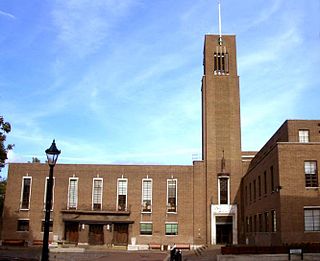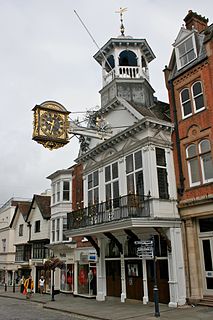
The London Borough of Haringey is a London borough in North London, classified by some definitions as part of Inner London, and by others as part of Outer London. It was created in 1965 by the amalgamation of three former boroughs. It shares borders with six other London boroughs. Clockwise from the north, they are: Enfield, Waltham Forest, Hackney, Islington, Camden, and Barnet.
Seven Sisters is a sub-district of Tottenham, north London in the United Kingdom, formerly within the municipal borough of Tottenham, which on 1 April 1965 was subsumed into the new London Borough of Haringey. It is located at the eastern end of Seven Sisters Road, which runs from Tottenham High Road to join the A1 in Holloway. It is within the South Tottenham postal district.

Hornsey Town Hall is a public building in Hatherley Gardens in the Crouch End area of Hornsey, London. The building was used by the Municipal Borough of Hornsey as its headquarters until 1966. It is a Grade II* listed building.

Broadwater Farm, often referred to simply as "The Farm", is an area in Tottenham, North London, straddling the River Moselle. The eastern half of the area is dominated by the Broadwater Farm Estate ("BWFE"), an experiment in high-density social housing, loosely based on Corbusian ideas, dominated by concrete towers connected by walkways, built in the late 1960s using cheap but fire-vulnerable pre-fabricated concrete panels. The western half of the area is taken up by Lordship Recreation Ground, one of north London's largest parks. Broadwater Farm in 2011 had a population of 4,844. The estate is owned by Haringey London Borough Council.

Barry Council Office and Library is a local government building and public library located in King Square, Barry, Wales. The building, which was once the meeting place of Barry Municipal Borough Council, is a Grade II listed building.

Tottenham is a town in north London, England, within the London Borough of Haringey. It is located in the ceremonial county of Greater London and the historic county of Middlesex. Tottenham is centred 6 miles (10 km) north-northeast of Charing Cross, bordering Edmonton to the north, Walthamstow, across the River Lea, to the east, and Stamford Hill to the south, with Wood Green and Harringay to the west.

The Guildford Guildhall is a Guildhall located on the High Street of the town of Guildford, Surrey. It is a Grade I listed building.

The North London Coroner's Court is a municipal building located at 29 Wood Street, Chipping Barnet, London. The building, which served as Barnet Town Hall, is a Grade II listed building.

Lambeth Town Hall, also known as Brixton Town Hall, is a municipal building at the corner of Brixton Hill and Acre Lane, Brixton, London. The town hall, which is the headquarters of Lambeth London Borough Council, is a Grade II listed building.

Gloucester Guildhall is a former municipal building in Eastgate Street, Gloucester, which is now used as a arts and theatre venue. It is a Grade II listed building.

Macclesfield Town Hall is a Georgian municipal building in the Market Place in Macclesfield, Cheshire, England. The building incorporates the former Borough Police Station. The town hall is listed at grade II*.

Acton Town Hall is a municipal building in High Street, Acton, London. It is a Grade II listed building.

George Meehan House is a municipal building in High Road, Wood Green, London. It is surrounded by a public park known as Woodside Park and is a locally listed building.

New Malden Town Hall is a municipal building in High Street, New Malden, London.

Redbridge Town Hall is a municipal building in High Road, Ilford, London. The town hall, which is the headquarters of Redbridge London Borough Council, is a Grade II listed building.

Leyton Town Hall is a municipal building in Adelaide Road, Leyton, London. The building, which includes Leyton Great Hall, is a Grade II listed building.

Bermondsey Town Hall is a municipal building in Spa Road, Bermondsey, London. It is a Grade II listed building.

Batley Town Hall is a municipal facility in the Market Place in Batley, West Yorkshire, England. It is a Grade II listed building.

Aldershot Town Hall is a municipal building in Grosvenor Road, Aldershot, Hampshire, England. The town hall, which was the headquarters of Aldershot Borough Council, is a Grade II listed building.

Purley Council Offices, also known as Purley Town Hall, is a former municipal building in Brighton Road, Purley, London. The structure, which was the headquarters of Coulsdon and Purley Urban District Council, is a Grade II listed building.




















